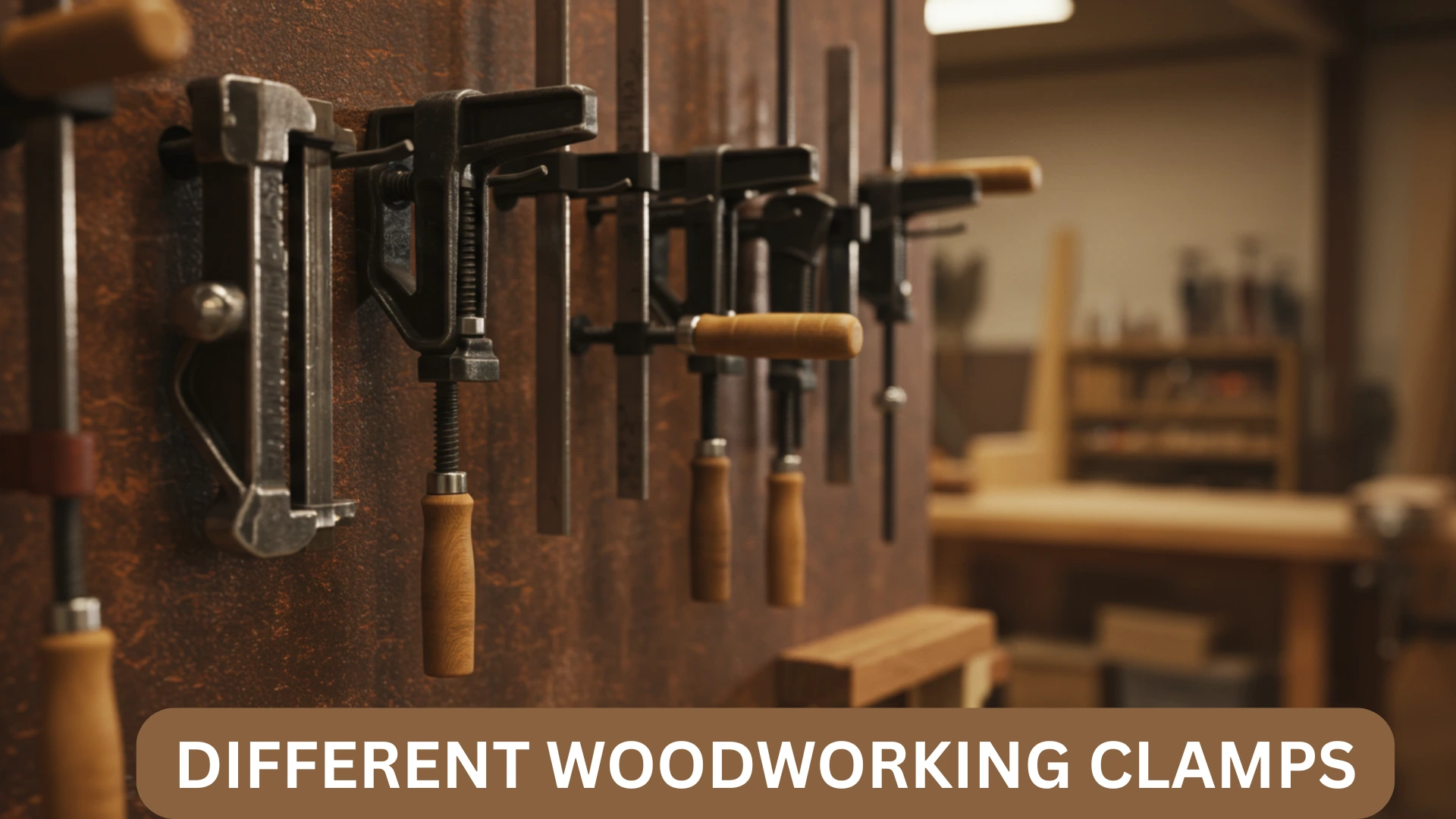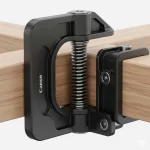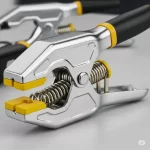
Types of Woodworking Clamps
There are various types of woodworking clamps available, each designed for different purposes. Here’s a quick overview:
- Bar Clamps: Known for their strength, bar clamps are perfect for large projects requiring significant pressure.
- Pipe Clamps: Versatile and adjustable, pipe clamps can be adapted to different sizes, making them ideal for various woodworking tasks.
- Toggle Clamps: These clamps provide a quick way to secure workpieces, often used in repetitive tasks.
- F-Clamps: Featuring a fixed jaw and an adjustable jaw, F-clamps are perfect for holding pieces together firmly.
- Corner Clamps: Useful for right-angle joints, corner clamps ensure that pieces stay aligned while you work.
Why Woodworking Clamps Matter
Woodworking clamps are not just accessories; they are vital components of successful woodworking projects. Here’s why:
- Stability: Clamps hold your pieces firmly in place, preventing movement while cutting, sanding, or gluing.
- Precision: By stabilizing components, clamps help maintain precise measurements and alignment.
- Efficiency: With clamps, you can work faster and more effectively, allowing for a smoother workflow.
- Safety: Holding components securely decreases the risk of accidents during cutting or power tool use.
Choosing the Right Clamp for Your Project
When it comes to woodworking, not every clamp suits every project. Here’s a handy table to help you choose:
| Clamp Type | Best For |
|---|---|
| Bar Clamp | Large panels and beams |
| Pipe Clamp | Variable sizes and extensive projects |
| Toggle Clamp | Quick operations and repeated tasks |
| F-Clamp | General purposes and woodworking joints |
| Corner Clamp | Furniture assembly and frames |

Tips for Using Woodworking Clamps Effectively
To make the most out of your clamps, consider these practical tips:
- Even Pressure: Apply even pressure to avoid damaging the wood. Adjust clamps slowly to distribute force evenly.
- Protect Your Workpieces: Use pads or blocks between the clamp jaws and your wood to prevent dents and scratches.
- Inspect Your Clamps: Regularly check for any damage or wear to ensure reliability.
- Use the Right Size: Make sure the clamps you choose can handle the size of your project. Oversized or undersized clamps can lead to ineffective tightening.
Storing and Maintaining Your Clamps
Proper storage and maintenance increase the longevity of your woodworking clamps. Here are some best practices:
- Store clamps in a dry area to prevent rust and damage.
- Keep clamps organized to quickly find the right size when you need them.
- Lubricate moving parts regularly to ensure smooth operation.
Investing in a good selection of woodworking clamps will enhance your efficiency and success in woodworking projects. As you grow your skills, clamps will remain a steadfast companion in your toolkit. For more detailed information on clamps and accessories, consider checking out resources like Wood Magazine and Shop Woodworking. They offer valuable insights and a wide array of products catering to all types of woodworkers.
Whether you’re crafting furniture or simple projects, remember that the right clamps can be your best ally in achieving high-quality results. Don’t underestimate their essential role in the woodworking journey!
Different Types of Woodworking Clamps and Their Uses
Woodworking clamps are essential tools for any woodworker, providing a reliable grip when assembling, gluing, or holding pieces together for various projects. Understanding the different types of clamps and their applications can significantly enhance your woodworking experience. Below is a guide to the most common woodworking clamps and how you can use them effectively.
Bar Clamps
 Bar clamps, also known as pipe clamps, use a long, flat bar as their base. They are favored for their versatility and ability to apply strong, even pressure over a wide area. Here’s how you can use them:
Bar clamps, also known as pipe clamps, use a long, flat bar as their base. They are favored for their versatility and ability to apply strong, even pressure over a wide area. Here’s how you can use them:
- Ideal for large assemblies: Bar clamps can hold large panels or frames flat while the glue dries.
- Adjustable length: By sliding the movable arm, you can adjust the clamp to different widths, making them suitable for various projects.
Pipe Clamps
 Though similar to bar clamps, pipe clamps make use of standard pipe for their beam. This feature allows for customizing the length according to your needs. They are most beneficial in the following ways:
Though similar to bar clamps, pipe clamps make use of standard pipe for their beam. This feature allows for customizing the length according to your needs. They are most beneficial in the following ways:
- Cost-effective: You can create your own clamp sizes by purchasing cut lengths of pipe and adding clamps.
- Strong hold: Pipe clamps offer excellent clamping force, which is particularly useful for larger projects.
F-Clamps
 F-clamps hold wood pieces in place using a large screw mechanism. They resemble the letter “F” when viewed from the side, which is how they acquire their name. Their uses include:
F-clamps hold wood pieces in place using a large screw mechanism. They resemble the letter “F” when viewed from the side, which is how they acquire their name. Their uses include:
- Quick adjustments: F-clamps can be adjusted quickly, making them ideal for situations where you need to apply and release pressure fast.
- Lightweight: These clamps are generally lightweight and easy to handle, reducing fatigue during prolonged use.
Corner Clamps
 Corner clamps play a crucial role when working with corners. They help maintain a 90-degree angle between two pieces of wood. Here’s why they’re indispensable:
Corner clamps play a crucial role when working with corners. They help maintain a 90-degree angle between two pieces of wood. Here’s why they’re indispensable:
- Simplifies assembly: They make assembling frames, boxes, and cabinets easier by holding the parts in a fixed position.
- Stable grip: Ensuring that your joints are square is essential, especially for aesthetic and strength purposes.
Spring Clamps
 Spring clamps are small and easy to use, made of plastic or metal. They provide a quick-and-easy clamping solution. Consider these points:
Spring clamps are small and easy to use, made of plastic or metal. They provide a quick-and-easy clamping solution. Consider these points:
- Fast operation: With just one hand, you can open and close a spring clamp, making it great for rapid tasks.
- Best for light tasks: Use these clamps for holding lightweight pieces together or when needing only minor pressure.
Pipe Clamps vs. Bar Clamps
When choosing between pipe clamps and bar clamps, consider the differences in convenience and cost. Below is a comparison table:
| Feature | Pipe Clamps | Bar Clamps |
|---|---|---|
| Custom Size | Yes, with pipe length | Fixed by size |
| Weight | Heavy | Lightweight |
| Cost | Generally lower | Varies greatly |
Which Clamp to Choose?
Your choice of clamp will depend on your specific project needs. Whether you need heavy-duty support for large projects or lightweight clamps for smaller tasks, knowing the differences can help you make the right choice. It’s beneficial to invest in a variety of clamps as different projects may require different tools.
If you are interested in expanding your knowledge on woodworking clamps, there are various resources available. Check out Wood Magazine for comprehensive guides and project ideas, or visit Popular Woodworking for tutorials and expert tips.
Understanding the different types of woodworking clamps can dramatically improve your projects’ quality and efficiency. Engage in a hands-on experience to fully appreciate the value each type of clamp provides.
How to Choose the Right Woodworking Clamp for Your Needs
Choosing the right woodworking clamp can greatly influence the success of your projects. With numerous types available, knowing what fits your needs is crucial. This guide will help you navigate through the selection process with ease.
Types of Woodworking Clamps
There are several types of woodworking clamps, each designed for specific tasks. Here’s a brief overview:
- Bar Clamps: These are versatile and ideal for a variety of projects. They have a long bar that provides even pressure.
- Pipe Clamps: Great for larger surfaces, these clamps use a pipe to create a sturdy holding point.
- C-Clamps: Small but powerful, C-clamps are perfect for securing joints in tight spaces.
- Spring Clamps: Easy to use, these clamps apply pressure automatically and are great for quick tasks.
- Corner Clamps: Specifically designed for making right angles, they are essential for frames and boxes.
- Band Clamps: Ideal for gluing irregular shapes, band clamps wrap around the item to apply pressure evenly.
Factors to Consider When Choosing Woodworking Clamps
When selecting a woodworking clamp, it’s important to consider several factors to ensure it meets your needs. Here’s what to keep in mind:
1. Project Size
Consider the size of the projects you usually undertake. For larger projects, you might need bar or pipe clamps that can span wider distances. Smaller tasks often require handheld clamps like C-clamps or spring clamps.
2. Pressure Capacity
Each clamp has a limit to the pressure it can exert. If you’re working with dense woods or thick materials, opt for clamps that can provide higher pressure without slipping.
3. Material of the Clamp
The material can affect durability and grip. Metal clamps are often stronger but can damage wood surfaces. Look for padded or plastic options if you’re concerned about leaving marks.
How to Use Woodworking Clamps Effectively
Understanding how to use clamps properly is just as important as choosing the right one. Here are some tips to maximize their effectiveness:
- Position Correctly: Ensure that the clamp is positioned squarely on the workpiece. Misalignment can lead to uneven pressure.
- Apply Even Pressure: Tighten the clamp gradually to distribute pressure evenly. Over-tightening can cause cracks.
- Use Blocks: To save your wood from clamp marks, place blocks between the clamp and the wood.
Where to Buy Quality Woodworking Clamps
Finding high-quality clamps is essential for quality projects. Here are some reputable online retailers where you can find a variety of woodworking clamps:
- Woodcraft – Offers a range of woodworking tools and clamps.
- Rockler – Known for specialty woodworking tools, including clamps.
- Amazon – Has a wide selection of woodworking clamps at various price points.
The right woodworking clamp is an essential tool for any woodworker. By understanding the types of clamps, factors to consider, and effective usage, you will find the best fit for your projects. Investing in quality clamps will not only enhance your craftsmanship but will also make your woodworking experience more enjoyable.
Always remember to keep your clamps in good condition by cleaning and storing them properly. Regular maintenance will ensure they last and perform optimally for years to come.
Tips for Maintaining Your Woodworking Clamps

Woodworking clamps are essential tools that help you create strong, stable joints in your projects. To keep these tools performing at their best, proper maintenance is crucial. Following a few simple tips can extend the life of your clamps and ensure they work effectively. Let’s explore some actionable steps you can take to maintain your woodworking clamps.
Regular Cleaning
Cleaning your woodworking clamps is the first step in maintenance. Dust, wood shavings, and resin can build up over time. This buildup can hinder the performance of your clamps. Here’s how to clean them effectively:
- Remove Residue: Use a soft-bristle brush or a cloth to wipe away any debris.
- Use Soapy Water: For tough stains, a mild soapy solution can work wonders. Just ensure you dry them thoroughly afterward.
- Inspect for Rust: If you notice rust, gently scrub the affected area with fine steel wool and then apply some oil.
Lubrication
Proper lubrication keeps moving parts of your clamps functioning smoothly. Here are some tips for effective lubrication:
- Choose the Right Lubricant: Use a light machine oil or silicone spray for best results.
- Apply Sparingly: You only need a small amount. Over-lubricating can attract more dust and create a mess.
- Check Frequently: Regularly check joints and sliding parts, especially after prolonged use.
Storage Solutions
Storing your clamps correctly plays a significant role in maintaining their condition. Here are some strategies:
- Keep Away from Moisture: Store your clamps in a dry place to prevent rust.
- Use Wall Space: Consider hanging them on a wall or pegboard to avoid damage from stacking.
- Organize by Type: Keep similar clamps together for easier access and lower the risk of misplacing them.
Inspection and Repair
Regular inspection helps you catch any issues before they become significant problems. Follow these steps:
- Check for Cracks: Examine your clamps for any signs of wear or damage.
- Test Functionality: Ensure all moving parts are working as intended. If you notice stiff or tightening points, apply some lubricant.
- Replace Worn Parts: If a part is damaged beyond repair, consider replacing it. Many brands offer replacement parts for their clamps.
Additional Tips for Maintenance
Taking care of your woodworking clamps can be straightforward. Here are some extra considerations:
- Know Your Clamps: Familiarize yourself with the specific care requirements for different clamp types, like bar, pipe, and spring clamps.
- Use Correctly: Always use clamps for their intended purpose to avoid unnecessary wear and tear.
- Follow Manufacturer Guidelines: Each brand has its care instructions. Refer to the manual provided when you purchased your clamps.
Remember that while maintaining woodworking clamps may seem secondary to the actual building process, neglecting them can lead to problems down the line. A well-maintained clamp not only enhances the quality of your work but also boosts your productivity.
Where to Buy Quality Woodworking Clamps
If you need to purchase or replace your woodworking clamps, consider visiting some reputable online stores. Websites like Woodcraft and Rockler offer a wide selection of high-quality clamps suitable for various projects.
By following these maintenance tips, your woodworking clamps will stay in great shape for years to come. This not only saves you money in the long run but also ensures that every woodworking project is carried out smoothly and efficiently.
Innovative Techniques for Using Woodworking Clamps in DIY Projects
When it comes to woodworking, clamps are your best friends. They are essential tools that help secure pieces together, making your projects easier and more precise. However, not all clamps are used the same way. You can enhance your DIY projects significantly by adopting innovative techniques with woodworking clamps.
One common hindrance in woodworking is ensuring that pieces stay together as you work on them. Often, you might face situations such as gluing joints or assembling frames where traditional clamps might fall short. Here are some innovative techniques to maximize the use of woodworking clamps in your projects:
1. Utilizing Pipe Clamps for Large Projects
Pipe clamps are versatile and can adjust to various sizes, making them perfect for large woodworking projects. To use pipe clamps effectively:
- Attach the clamp to the pipe, ensuring the clamp head is on the correct side.
- Slide the wooden pieces onto the pipe, positioning them before tightening.
- Adjust the clamp to achieve even pressure across the workpiece.
This method allows you to handle large panels and frames without needing multiple smaller clamps, saving both time and effort.
2. Employing Band Clamps for Non-Rectangular Shapes
When you’re working with round or irregular shapes, regular clamps might not work effectively. Band clamps are designed specifically for this purpose. Here’s how to use them:
- Wrap the band around the pieces you want to join.
- Ensure that the band is positioned evenly around the object.
- Pull the tension strap, adjusting as necessary to make sure everything fits snugly together.
Using band clamps allows you to clamp multi-sided objects securely without marring the surface of your workpiece.
3. Leveraging Corner Clamps for Perfect Angles
Making right angles can be tricky, especially if you’re new to woodworking. Corner clamps are fundamental in this aspect. Here’s how to use them:
- Position the corners of your wood pieces within the corners of the clamp.
- Tighten the clamp to hold everything in place.
- Check that the angles are square using a square tool.
This technique ensures that your joints are square, leading to a finished product that is not only stronger but also visually appealing.
4. Creative Use of Spring Clamps
Spring clamps are small but mighty, making them perfect for holding smaller pieces together. You can use them innovatively in various ways:
- To hold pieces while gluing, spring clamps can provide quick and easy setup.
- Use them to secure templates or jigs down to your work surface.
- They can also be applied to hold down thin pieces of wood while cutting.
This technique no longer limits you to just the traditional clamps for heavy-duty tasks.
5. Experimenting with Multiple Clamps
Don’t hesitate to mix and match different types of clamps to achieve the desired results. Here are a few combinations to consider:
- Use bar clamps with spring clamps for added security.
- Pair pipe clamps with corner clamps to keep larger frames square.
- Mix large clamps with smaller clamps for precision on complex assemblies.
By experimenting with various clamps, you can create a more flexible and efficient workflow for your projects.
For those embarking on DIY projects, understanding how to manage woodworking clamps can be a game-changer. The ability to innovate with various types of clamps not only enhances the quality of your work but also improves efficiency. If you want to explore more on woodworking techniques, check out resources at Wood Magazine or Woodworking Network.
In your next project, consider how these innovative techniques with woodworking clamps can save you time and enhance your craftsmanship. You might find yourself enjoying the process even more!
